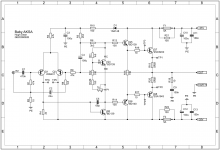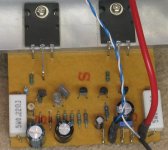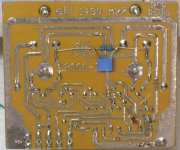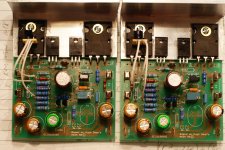Hello
I've re-read all the thread for the Baby Aksa numbers to find an open loop gain of 75 db with a BD139 VAS and a close loop gain of 30 db, so a negative feedback factor of 40 db.
Using LTspice and putting an infinitely large cap from the feedback node straight to ground to measure negative feedback factor did work ok for the Baby Aksa schematic but it still not give realistic numbers wen using this method in LTspice with more complex amps schematic.
Thank
Bye
Gaetan
I've re-read all the thread for the Baby Aksa numbers to find an open loop gain of 75 db with a BD139 VAS and a close loop gain of 30 db, so a negative feedback factor of 40 db.
Using LTspice and putting an infinitely large cap from the feedback node straight to ground to measure negative feedback factor did work ok for the Baby Aksa schematic but it still not give realistic numbers wen using this method in LTspice with more complex amps schematic.
Thank
Bye
Gaetan
Last edited:
Hello
Using LTspice and putting an infinitely large cap from the feedback node straight to ground to measure negative feedback factor did work ok for the Baby Aksa schematic but it still not give realistic numbers wen using this method in LTspice with more complex amps schematic.
Thank
Bye
Gaetan
It should work..
Use a cap of 100 F.
A strictly infinite cap can create divergence calculus..
I've started stuffing the boards that I have received. Thanks to Rabbitz generosity, I am able to try the AKSA sound even if not 100%.
My question is do the drivers 2SC4793 and 2SA1837, need to be heatsinked. I've seen on the first page that Gregg has them freestanding and lying on the sink.
My question is do the drivers 2SC4793 and 2SA1837, need to be heatsinked. I've seen on the first page that Gregg has them freestanding and lying on the sink.
My question is do the drivers 2SC4793 and 2SA1837, need to be heatsinked. I've seen on the first page that Gregg has them freestanding and lying on the sink.
Hi wendell c,
I think this is one of those questions where you will get both yes and no answers.
Mine are all free standing. The ones lying on the heatsink are really just bent forward out of the way of the output terminal. Rabbitz has his bent forward over the heatsink and firmly attached with a small aluminum bracket.
Note when they are bend over the heatsink and are actually upside down.
My original AKSA 55 had the drivers free standing for years without a problem. On the later versions, Hugh mounted them on the main heatsink. The AKSA 100 has them freestanding but with an additional heatsink attached.
regards
it depends on the driver bias current which in turn determines the quiescent dissipation of the driver transistors.I think this is one of those questions where you will get both yes and no answers.
At what temperature do you want your drivers to run?
Cold, warm or hot.
I prefer towards the cold end of the temperature spectrum to reduce working stresses and to reduce time to reach temperature stability and to reduce the change in parameters as the devices rise to final working temperature.
But cold operating temperatures does not force me down the route of adopting less than optimal operating current.
You are up late I think, Andrew.At what temperature do you want your drivers to run?
Cold, warm or hot..
Just a little history here: AKSA and Greg would know that the protoytype amp, known here in Oz from the '80s as "Digi 125" by Graham Dicker used (wait for it) TO92 types BC546/56 as drivers for either 2N3055s for 60 Watts or MJ802/4502 for 125W (4 ohm load). Yes, and tested by ETI magazine workshop as reliably doing so.
Sure, current may be a different and we need to take it easy on all parts for DIY safety margins but some things really amaze, eh? 😱
Wendell,
No heatsink required, but Andrew is right, cooler is better..... though dissipation on a robust TO220 package is 6.5 x 37 = 240 milliwatts at idle, rising to about double this at full tilt. Without a heatsink these packages will reliably go to about 1W continuous, even in a hot climate, so there is no concern either way. You can make your choice, of course, though in Vegas playing Hotel California in the hot sun at a drunken pool party, some cooling would be advisable and may slightly improve MTBF....
Ian is right, the Digi 125 was indeed an early influence, but the AKSA has a few extra features that make a marked, subjective difference to the sound quality.
Hugh
No heatsink required, but Andrew is right, cooler is better..... though dissipation on a robust TO220 package is 6.5 x 37 = 240 milliwatts at idle, rising to about double this at full tilt. Without a heatsink these packages will reliably go to about 1W continuous, even in a hot climate, so there is no concern either way. You can make your choice, of course, though in Vegas playing Hotel California in the hot sun at a drunken pool party, some cooling would be advisable and may slightly improve MTBF....
Ian is right, the Digi 125 was indeed an early influence, but the AKSA has a few extra features that make a marked, subjective difference to the sound quality.
Hugh
Thanks for the clarification gentlemen. I guess I won't worry too much about it and will add the sink at my discretion.
Gregg, that is the whole reason for my question. Because it is mounted backwards, face down on sink, I was wondering what is the best way to mount a sink. Doesn't the sink need to be mounted on the backside for efficiency purpose?
Gregg, that is the whole reason for my question. Because it is mounted backwards, face down on sink, I was wondering what is the best way to mount a sink. Doesn't the sink need to be mounted on the backside for efficiency purpose?
Thanks for the clarification gentlemen. I guess I won't worry too much about it and will add the sink at my discretion.
Gregg, that is the whole reason for my question. Because it is mounted back wards, face down on sink, I was wondering what is the best way to mount a sink. Doesn't the sink need to be mounted on the backside for efficiency purpose?
Hi wendell c,
There are only face down because the PCB was designed for a BD139/BD140 drivers.
I like the way Rabbitz mounted them in post #388.
On the test bench, the free standing drivers run a few degrees warmer than the output transistors, below 40 degrees, so not much to worry about IMHO.
Also, this is DIY, part of the exercise is learning from actual experience, try free standing, add small heat sinks if they are getting too hot, finally mount on main heat sink, if it is the easiest solution.
regards
Ian is right, the Digi 125 was indeed an early influence, but the AKSA has a few extra features that make a marked, subjective difference to the sound quality.
You are up late I think, Andrew.
Just a little history here: AKSA and Greg would know that the protoytype amp, known here in Oz from the '80s as "Digi 125" by Graham Dicker used (wait for it) TO92 types BC546/56 as drivers for either 2N3055s for 60 Watts or MJ802/4502 for 125W (4 ohm load). Yes, and tested by ETI magazine workshop as reliably doing so.
Sure, current may be a different and we need to take it easy on all parts for DIY safety margins but some things really amaze, eh? 😱
Yep, here is a picture of my DIGI 125 from many years ago, TO92 drivers and all. I have added a bootstrap, increased the bias, added base stoppers and changed the VAS transistor.
It didn't blow up or fail during the many hours of testing.
Attachments
but the AKSA has a few extra features that make a marked, subjective difference to the sound quality.
Hugh
Hi , Hugh
Is it because it has this kind of THD distribution...?.....
Attachments
Yep, here is a picture of my DIGI 125 from many years ago, TO92 drivers and all. I have added a bootstrap, increased the bias, added base stoppers and changed the VAS transistor.
It didn't blow up or fail during the many hours of testing.
Greg
Did you also add a collector resistor to the input pair, where the original went straight to the supply rail ?
If nothing else it helps to keep the transistors at a similar temperature.
Regards
Alex
Greg
Did you also add a collector resistor to the input pair, where the original went straight to the supply rail ?
If nothing else it helps to keep the transistors at a similar temperature.
Regards
Alex
Hi Alex,
No, I left it as per the original schematic. The input pair part of the circuit topology is the same on the DIGI 125 and BAKSA (there are a few component differences though).
regards
Wahab,
Maybe. Your profile is rather more flattering than mine......
Well, H2 at about -73db , H3 at -85db...
At 1KHZ/25W RMS, that s not exactly what can be
called low THD although i m almost sure i wouldn t notice
any difference with an amp that would have far lower
ratios in an audition test...
Wahab,
You'd be surprised.
H2 and H3 are not particularly important.
Best,
Hugh
Musically speaking, sure that the concerns are differents as
the worse are, in order of decreasing "awfulness", H11 , H13,
H7,H5 and its octave H10...
H3 is important if the music is to contain lots of diminished chords..
H5 is important when music is minor chords oriented , as often
with modal musics..
In short, if the amps were to distort badly, then each one would
suit only to a limited musical repertory..
Fortunately, the vast majority has low enough THD ratios..
MY Baby AKSA Build
Here is my BAKSA, need some 10r resistors. Does the quality of the 10r resistors on r16/17 make a difference?
I've pretty much used KOA 1% metal films with some Vishays. I have some cheap 10r carbon films from Radio Shack 5% and will use them just to get this going and replace if you folks tell me it will degrade performance.
I have 2sc3423 for VAS, and drivers are 2sc4793/2sa1837.
Need to get some silver micas, the values I have are 100pf and up. I do have some polysterene in 33/47/68pf, are interchangeable for c5?
I did not get the recommended nichicon KZ for the c4, I got a silmic ii instead since that is what DK had in stock.
I pretty much went with the recommended values on Greg's BOM as well as Rabbitz recommendations.
Rabbitz, on one of your pics I see that you have a silver mica cap near the row of resistors. What does that do?
Thanks
Here is my BAKSA, need some 10r resistors. Does the quality of the 10r resistors on r16/17 make a difference?
I've pretty much used KOA 1% metal films with some Vishays. I have some cheap 10r carbon films from Radio Shack 5% and will use them just to get this going and replace if you folks tell me it will degrade performance.
I have 2sc3423 for VAS, and drivers are 2sc4793/2sa1837.
Need to get some silver micas, the values I have are 100pf and up. I do have some polysterene in 33/47/68pf, are interchangeable for c5?
I did not get the recommended nichicon KZ for the c4, I got a silmic ii instead since that is what DK had in stock.
I pretty much went with the recommended values on Greg's BOM as well as Rabbitz recommendations.
Rabbitz, on one of your pics I see that you have a silver mica cap near the row of resistors. What does that do?
Thanks
Attachments
- Home
- Amplifiers
- Solid State
- Based on Hugh Dean's AKSA 55



